Exploring Participatory Governance in Environmental Decision-Making
VerifiedAdded on 2023/04/20
|6
|1512
|484
Essay
AI Summary
This essay examines participatory governance and its influence on environmental decision-making processes. It defines participatory governance as practices promoting democracy at institutional and governmental levels, highlighting citizen involvement through voting, polling, and participation in decision-making bodies. The essay explores the impact of participatory governance on environmental decisions, weighing its benefits, such as increased social acceptability and sustainable management, against potential drawbacks like slower decision-making and cultural clashes. A case study from a Canadian hospital illustrates both the successes and challenges of implementing participatory management techniques. The essay concludes that incorporating individual needs and perspectives is crucial for effective ecosystem management, achieved through collaborative interactions and informed decision-making.
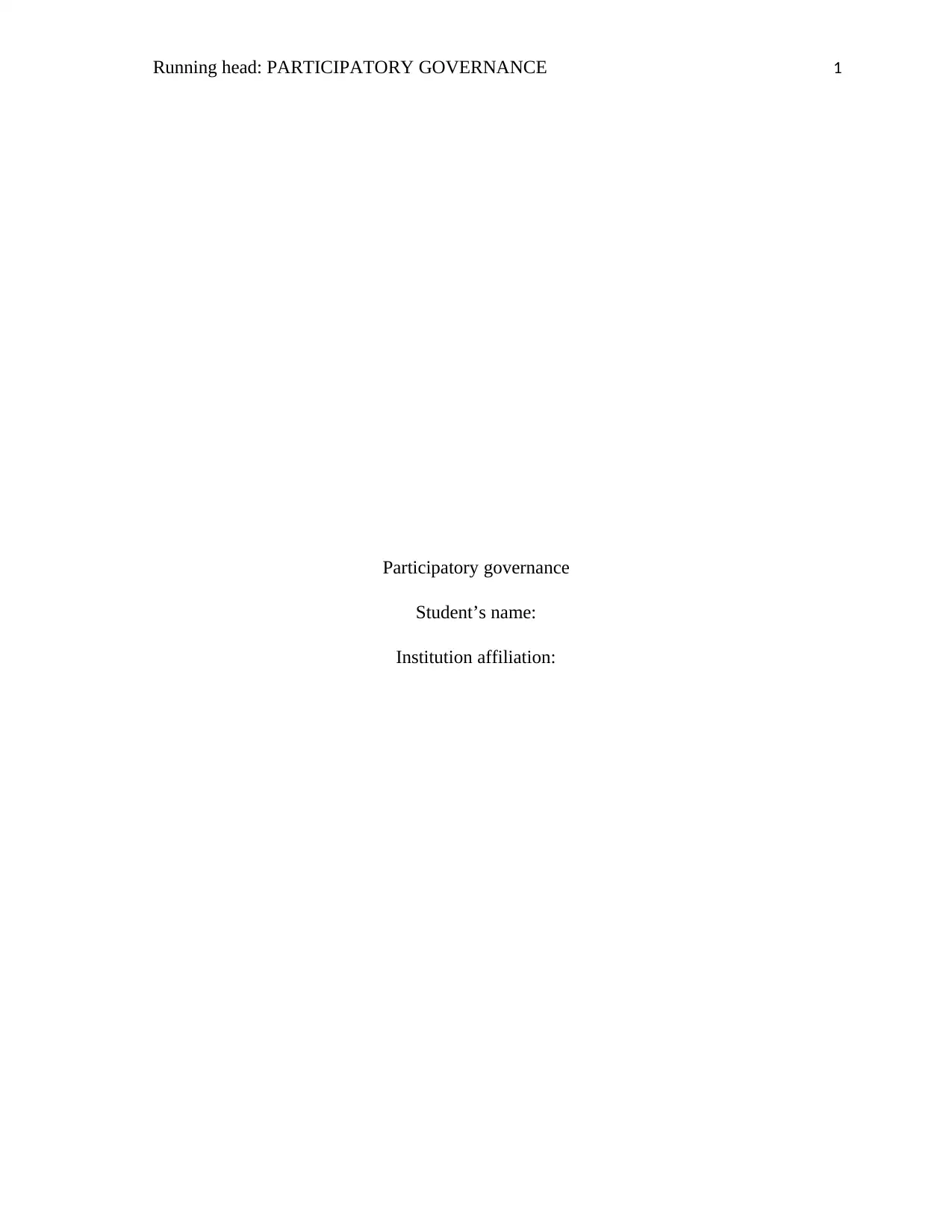
Running head: PARTICIPATORY GOVERNANCE 1
Participatory governance
Student’s name:
Institution affiliation:
Participatory governance
Student’s name:
Institution affiliation:
Paraphrase This Document
Need a fresh take? Get an instant paraphrase of this document with our AI Paraphraser
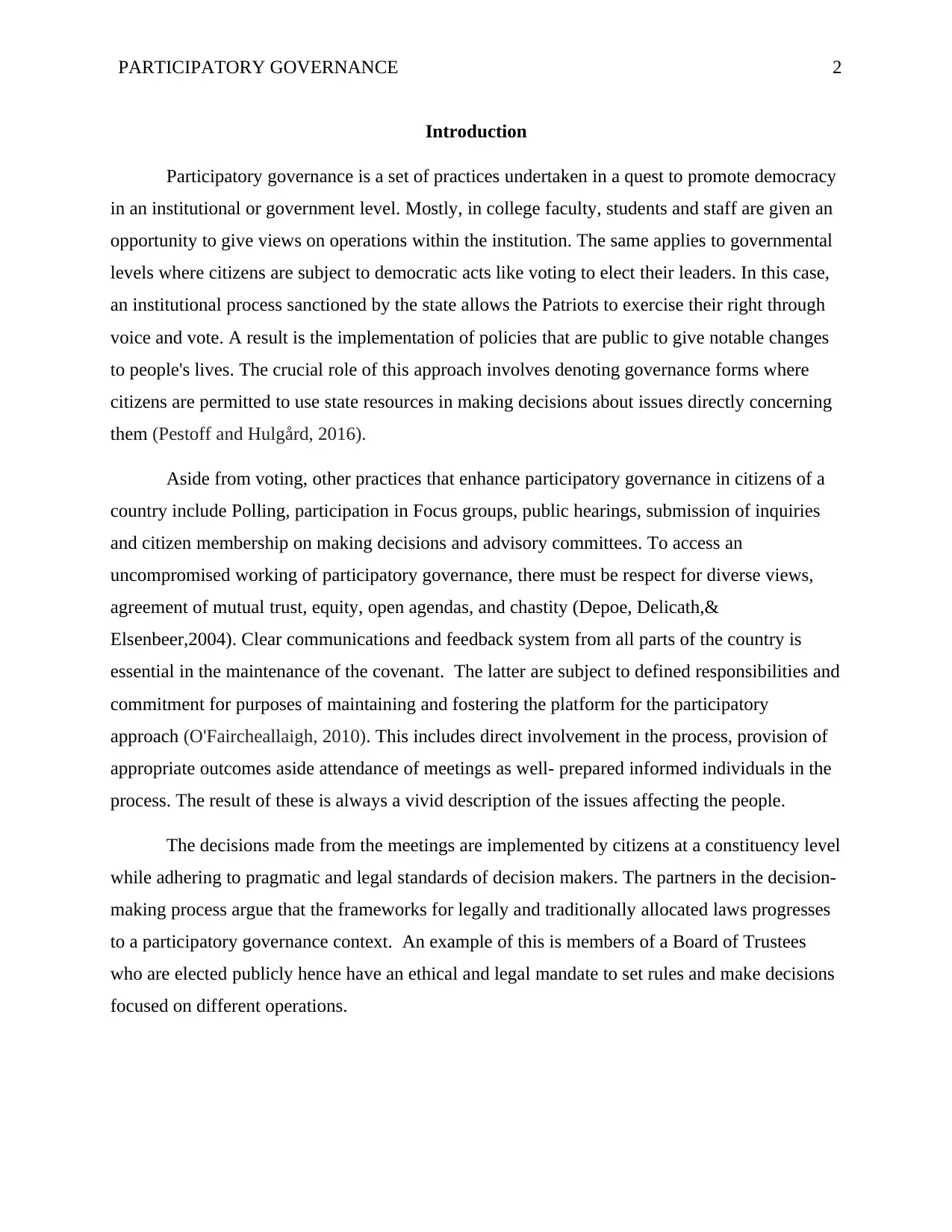
PARTICIPATORY GOVERNANCE 2
Introduction
Participatory governance is a set of practices undertaken in a quest to promote democracy
in an institutional or government level. Mostly, in college faculty, students and staff are given an
opportunity to give views on operations within the institution. The same applies to governmental
levels where citizens are subject to democratic acts like voting to elect their leaders. In this case,
an institutional process sanctioned by the state allows the Patriots to exercise their right through
voice and vote. A result is the implementation of policies that are public to give notable changes
to people's lives. The crucial role of this approach involves denoting governance forms where
citizens are permitted to use state resources in making decisions about issues directly concerning
them (Pestoff and Hulgård, 2016).
Aside from voting, other practices that enhance participatory governance in citizens of a
country include Polling, participation in Focus groups, public hearings, submission of inquiries
and citizen membership on making decisions and advisory committees. To access an
uncompromised working of participatory governance, there must be respect for diverse views,
agreement of mutual trust, equity, open agendas, and chastity (Depoe, Delicath,&
Elsenbeer,2004). Clear communications and feedback system from all parts of the country is
essential in the maintenance of the covenant. The latter are subject to defined responsibilities and
commitment for purposes of maintaining and fostering the platform for the participatory
approach (O'Faircheallaigh, 2010). This includes direct involvement in the process, provision of
appropriate outcomes aside attendance of meetings as well- prepared informed individuals in the
process. The result of these is always a vivid description of the issues affecting the people.
The decisions made from the meetings are implemented by citizens at a constituency level
while adhering to pragmatic and legal standards of decision makers. The partners in the decision-
making process argue that the frameworks for legally and traditionally allocated laws progresses
to a participatory governance context. An example of this is members of a Board of Trustees
who are elected publicly hence have an ethical and legal mandate to set rules and make decisions
focused on different operations.
Introduction
Participatory governance is a set of practices undertaken in a quest to promote democracy
in an institutional or government level. Mostly, in college faculty, students and staff are given an
opportunity to give views on operations within the institution. The same applies to governmental
levels where citizens are subject to democratic acts like voting to elect their leaders. In this case,
an institutional process sanctioned by the state allows the Patriots to exercise their right through
voice and vote. A result is the implementation of policies that are public to give notable changes
to people's lives. The crucial role of this approach involves denoting governance forms where
citizens are permitted to use state resources in making decisions about issues directly concerning
them (Pestoff and Hulgård, 2016).
Aside from voting, other practices that enhance participatory governance in citizens of a
country include Polling, participation in Focus groups, public hearings, submission of inquiries
and citizen membership on making decisions and advisory committees. To access an
uncompromised working of participatory governance, there must be respect for diverse views,
agreement of mutual trust, equity, open agendas, and chastity (Depoe, Delicath,&
Elsenbeer,2004). Clear communications and feedback system from all parts of the country is
essential in the maintenance of the covenant. The latter are subject to defined responsibilities and
commitment for purposes of maintaining and fostering the platform for the participatory
approach (O'Faircheallaigh, 2010). This includes direct involvement in the process, provision of
appropriate outcomes aside attendance of meetings as well- prepared informed individuals in the
process. The result of these is always a vivid description of the issues affecting the people.
The decisions made from the meetings are implemented by citizens at a constituency level
while adhering to pragmatic and legal standards of decision makers. The partners in the decision-
making process argue that the frameworks for legally and traditionally allocated laws progresses
to a participatory governance context. An example of this is members of a Board of Trustees
who are elected publicly hence have an ethical and legal mandate to set rules and make decisions
focused on different operations.
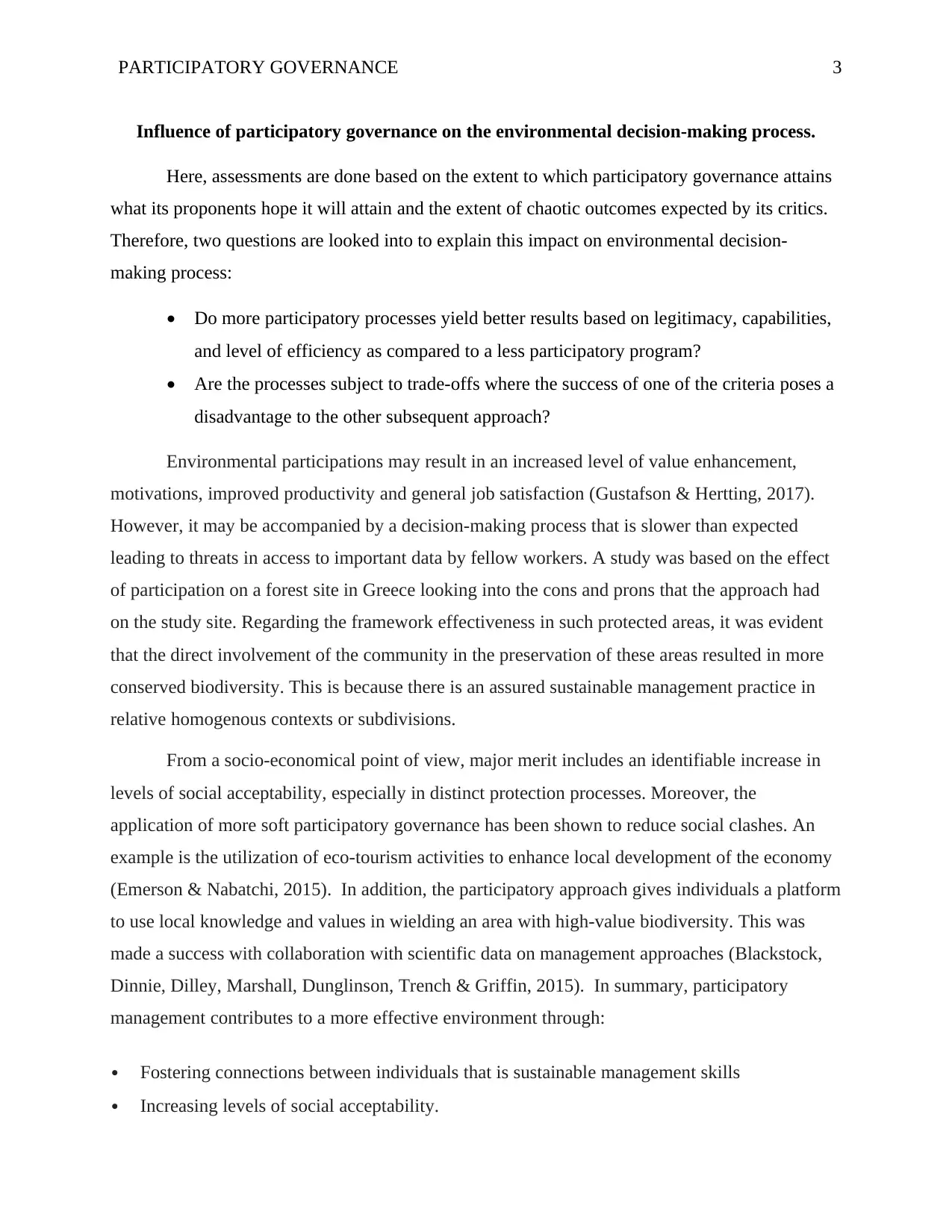
PARTICIPATORY GOVERNANCE 3
Influence of participatory governance on the environmental decision-making process.
Here, assessments are done based on the extent to which participatory governance attains
what its proponents hope it will attain and the extent of chaotic outcomes expected by its critics.
Therefore, two questions are looked into to explain this impact on environmental decision-
making process:
• Do more participatory processes yield better results based on legitimacy, capabilities,
and level of efficiency as compared to a less participatory program?
• Are the processes subject to trade-offs where the success of one of the criteria poses a
disadvantage to the other subsequent approach?
Environmental participations may result in an increased level of value enhancement,
motivations, improved productivity and general job satisfaction (Gustafson & Hertting, 2017).
However, it may be accompanied by a decision-making process that is slower than expected
leading to threats in access to important data by fellow workers. A study was based on the effect
of participation on a forest site in Greece looking into the cons and prons that the approach had
on the study site. Regarding the framework effectiveness in such protected areas, it was evident
that the direct involvement of the community in the preservation of these areas resulted in more
conserved biodiversity. This is because there is an assured sustainable management practice in
relative homogenous contexts or subdivisions.
From a socio-economical point of view, major merit includes an identifiable increase in
levels of social acceptability, especially in distinct protection processes. Moreover, the
application of more soft participatory governance has been shown to reduce social clashes. An
example is the utilization of eco-tourism activities to enhance local development of the economy
(Emerson & Nabatchi, 2015). In addition, the participatory approach gives individuals a platform
to use local knowledge and values in wielding an area with high-value biodiversity. This was
made a success with collaboration with scientific data on management approaches (Blackstock,
Dinnie, Dilley, Marshall, Dunglinson, Trench & Griffin, 2015). In summary, participatory
management contributes to a more effective environment through:
Fostering connections between individuals that is sustainable management skills
Increasing levels of social acceptability.
Influence of participatory governance on the environmental decision-making process.
Here, assessments are done based on the extent to which participatory governance attains
what its proponents hope it will attain and the extent of chaotic outcomes expected by its critics.
Therefore, two questions are looked into to explain this impact on environmental decision-
making process:
• Do more participatory processes yield better results based on legitimacy, capabilities,
and level of efficiency as compared to a less participatory program?
• Are the processes subject to trade-offs where the success of one of the criteria poses a
disadvantage to the other subsequent approach?
Environmental participations may result in an increased level of value enhancement,
motivations, improved productivity and general job satisfaction (Gustafson & Hertting, 2017).
However, it may be accompanied by a decision-making process that is slower than expected
leading to threats in access to important data by fellow workers. A study was based on the effect
of participation on a forest site in Greece looking into the cons and prons that the approach had
on the study site. Regarding the framework effectiveness in such protected areas, it was evident
that the direct involvement of the community in the preservation of these areas resulted in more
conserved biodiversity. This is because there is an assured sustainable management practice in
relative homogenous contexts or subdivisions.
From a socio-economical point of view, major merit includes an identifiable increase in
levels of social acceptability, especially in distinct protection processes. Moreover, the
application of more soft participatory governance has been shown to reduce social clashes. An
example is the utilization of eco-tourism activities to enhance local development of the economy
(Emerson & Nabatchi, 2015). In addition, the participatory approach gives individuals a platform
to use local knowledge and values in wielding an area with high-value biodiversity. This was
made a success with collaboration with scientific data on management approaches (Blackstock,
Dinnie, Dilley, Marshall, Dunglinson, Trench & Griffin, 2015). In summary, participatory
management contributes to a more effective environment through:
Fostering connections between individuals that is sustainable management skills
Increasing levels of social acceptability.
⊘ This is a preview!⊘
Do you want full access?
Subscribe today to unlock all pages.

Trusted by 1+ million students worldwide
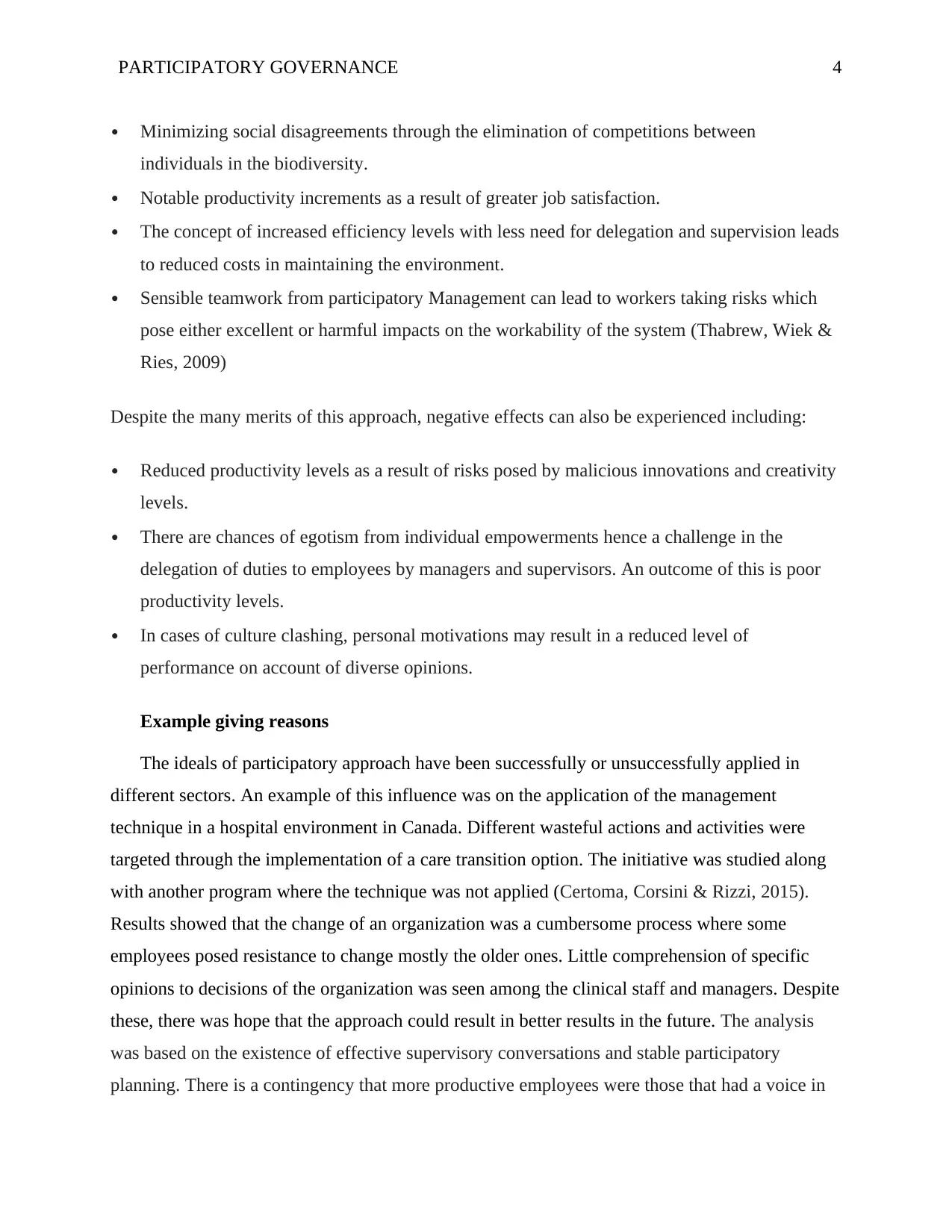
PARTICIPATORY GOVERNANCE 4
Minimizing social disagreements through the elimination of competitions between
individuals in the biodiversity.
Notable productivity increments as a result of greater job satisfaction.
The concept of increased efficiency levels with less need for delegation and supervision leads
to reduced costs in maintaining the environment.
Sensible teamwork from participatory Management can lead to workers taking risks which
pose either excellent or harmful impacts on the workability of the system (Thabrew, Wiek &
Ries, 2009)
Despite the many merits of this approach, negative effects can also be experienced including:
Reduced productivity levels as a result of risks posed by malicious innovations and creativity
levels.
There are chances of egotism from individual empowerments hence a challenge in the
delegation of duties to employees by managers and supervisors. An outcome of this is poor
productivity levels.
In cases of culture clashing, personal motivations may result in a reduced level of
performance on account of diverse opinions.
Example giving reasons
The ideals of participatory approach have been successfully or unsuccessfully applied in
different sectors. An example of this influence was on the application of the management
technique in a hospital environment in Canada. Different wasteful actions and activities were
targeted through the implementation of a care transition option. The initiative was studied along
with another program where the technique was not applied (Certoma, Corsini & Rizzi, 2015).
Results showed that the change of an organization was a cumbersome process where some
employees posed resistance to change mostly the older ones. Little comprehension of specific
opinions to decisions of the organization was seen among the clinical staff and managers. Despite
these, there was hope that the approach could result in better results in the future. The analysis
was based on the existence of effective supervisory conversations and stable participatory
planning. There is a contingency that more productive employees were those that had a voice in
Minimizing social disagreements through the elimination of competitions between
individuals in the biodiversity.
Notable productivity increments as a result of greater job satisfaction.
The concept of increased efficiency levels with less need for delegation and supervision leads
to reduced costs in maintaining the environment.
Sensible teamwork from participatory Management can lead to workers taking risks which
pose either excellent or harmful impacts on the workability of the system (Thabrew, Wiek &
Ries, 2009)
Despite the many merits of this approach, negative effects can also be experienced including:
Reduced productivity levels as a result of risks posed by malicious innovations and creativity
levels.
There are chances of egotism from individual empowerments hence a challenge in the
delegation of duties to employees by managers and supervisors. An outcome of this is poor
productivity levels.
In cases of culture clashing, personal motivations may result in a reduced level of
performance on account of diverse opinions.
Example giving reasons
The ideals of participatory approach have been successfully or unsuccessfully applied in
different sectors. An example of this influence was on the application of the management
technique in a hospital environment in Canada. Different wasteful actions and activities were
targeted through the implementation of a care transition option. The initiative was studied along
with another program where the technique was not applied (Certoma, Corsini & Rizzi, 2015).
Results showed that the change of an organization was a cumbersome process where some
employees posed resistance to change mostly the older ones. Little comprehension of specific
opinions to decisions of the organization was seen among the clinical staff and managers. Despite
these, there was hope that the approach could result in better results in the future. The analysis
was based on the existence of effective supervisory conversations and stable participatory
planning. There is a contingency that more productive employees were those that had a voice in
Paraphrase This Document
Need a fresh take? Get an instant paraphrase of this document with our AI Paraphraser

PARTICIPATORY GOVERNANCE 5
the decision-making process of the institution as compared to the others deprived of the
opportunity. In conclusion, it is clear that the inclusion of individuals and their needs pertaining
to economic issues is a mandatory part of ecosystem management objectives. An effectively
working system is achieved through individual interactions through the implementation of their
factual decisions.
the decision-making process of the institution as compared to the others deprived of the
opportunity. In conclusion, it is clear that the inclusion of individuals and their needs pertaining
to economic issues is a mandatory part of ecosystem management objectives. An effectively
working system is achieved through individual interactions through the implementation of their
factual decisions.
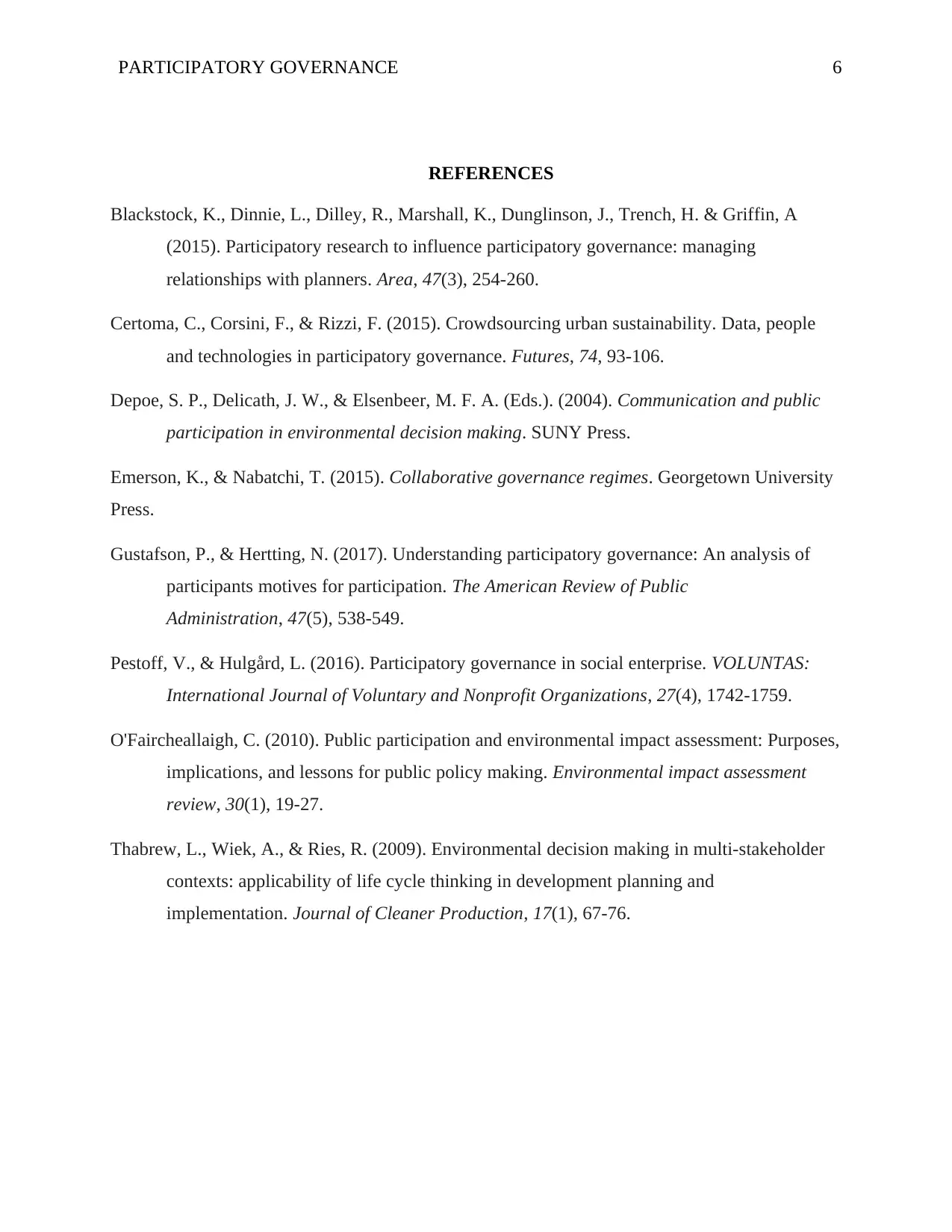
PARTICIPATORY GOVERNANCE 6
REFERENCES
Blackstock, K., Dinnie, L., Dilley, R., Marshall, K., Dunglinson, J., Trench, H. & Griffin, A
(2015). Participatory research to influence participatory governance: managing
relationships with planners. Area, 47(3), 254-260.
Certoma, C., Corsini, F., & Rizzi, F. (2015). Crowdsourcing urban sustainability. Data, people
and technologies in participatory governance. Futures, 74, 93-106.
Depoe, S. P., Delicath, J. W., & Elsenbeer, M. F. A. (Eds.). (2004). Communication and public
participation in environmental decision making. SUNY Press.
Emerson, K., & Nabatchi, T. (2015). Collaborative governance regimes. Georgetown University
Press.
Gustafson, P., & Hertting, N. (2017). Understanding participatory governance: An analysis of
participants motives for participation. The American Review of Public
Administration, 47(5), 538-549.
Pestoff, V., & Hulgård, L. (2016). Participatory governance in social enterprise. VOLUNTAS:
International Journal of Voluntary and Nonprofit Organizations, 27(4), 1742-1759.
O'Faircheallaigh, C. (2010). Public participation and environmental impact assessment: Purposes,
implications, and lessons for public policy making. Environmental impact assessment
review, 30(1), 19-27.
Thabrew, L., Wiek, A., & Ries, R. (2009). Environmental decision making in multi-stakeholder
contexts: applicability of life cycle thinking in development planning and
implementation. Journal of Cleaner Production, 17(1), 67-76.
REFERENCES
Blackstock, K., Dinnie, L., Dilley, R., Marshall, K., Dunglinson, J., Trench, H. & Griffin, A
(2015). Participatory research to influence participatory governance: managing
relationships with planners. Area, 47(3), 254-260.
Certoma, C., Corsini, F., & Rizzi, F. (2015). Crowdsourcing urban sustainability. Data, people
and technologies in participatory governance. Futures, 74, 93-106.
Depoe, S. P., Delicath, J. W., & Elsenbeer, M. F. A. (Eds.). (2004). Communication and public
participation in environmental decision making. SUNY Press.
Emerson, K., & Nabatchi, T. (2015). Collaborative governance regimes. Georgetown University
Press.
Gustafson, P., & Hertting, N. (2017). Understanding participatory governance: An analysis of
participants motives for participation. The American Review of Public
Administration, 47(5), 538-549.
Pestoff, V., & Hulgård, L. (2016). Participatory governance in social enterprise. VOLUNTAS:
International Journal of Voluntary and Nonprofit Organizations, 27(4), 1742-1759.
O'Faircheallaigh, C. (2010). Public participation and environmental impact assessment: Purposes,
implications, and lessons for public policy making. Environmental impact assessment
review, 30(1), 19-27.
Thabrew, L., Wiek, A., & Ries, R. (2009). Environmental decision making in multi-stakeholder
contexts: applicability of life cycle thinking in development planning and
implementation. Journal of Cleaner Production, 17(1), 67-76.
⊘ This is a preview!⊘
Do you want full access?
Subscribe today to unlock all pages.

Trusted by 1+ million students worldwide
1 out of 6
Related Documents
Your All-in-One AI-Powered Toolkit for Academic Success.
+13062052269
info@desklib.com
Available 24*7 on WhatsApp / Email
![[object Object]](/_next/static/media/star-bottom.7253800d.svg)
Unlock your academic potential
Copyright © 2020–2025 A2Z Services. All Rights Reserved. Developed and managed by ZUCOL.





